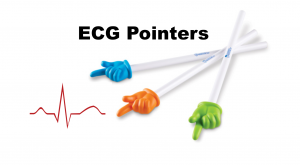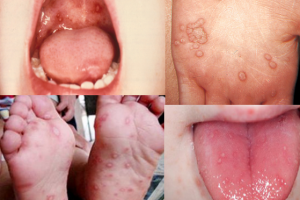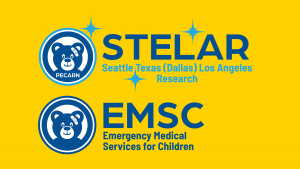Today on the emDOCs cast with Brit Long, MD (@long_brit) and Rachel Bridwell, MD (@rebridwell), we cover Lemierre’s syndrome and retropharyngeal abscess.
Lemierre’s Syndrome
Epidemiology:
- Suppurative thrombophlebitis of the internal jugular vein
- Incidence of 3.6 cases per 1 million persons
- Predominantly in 15-24 year old
- Resurgence in Group A streptococcus negative rapid testing
- Pathophysiology: hematogenous spread of bacteria from commonly an oropharyngeal infection via tonsillar vein vs. lymphangitis
- Cases can occur after tonsillitis (37%), pharyngitis (30%)
- More rare sources include:
- Mandibular fracture
- Bartholin gland abscess with hematogenous spread
- Mortality was previously 90%, but more recent rates are 5-10% with early antibiotics
- Increased incidence with antibiotic resistance, decreased tonsillectomies, and use of rapid Strep pharyngitis testing
- Named for Anton Lemierre who published a 20 patient case series of this disease—18 patients in that cohort died
Microbiology:
- Oral flora:
- Fusobacterium necrophorum (classically—accounts for 33%)
- Fusobacterium nucleatum
- Streptococcus
- Staphylococcus
- Klebsiella pneumoniae
Evaluation:
- Assess ABCs and begin resuscitation
- May present with toxic appearance
- Shock is unsurprisingly associated with increased mortality
- Up to 97% will experience a cough, which can be due to septic pulmonary emboli
- Abdominal symptoms to include nausea, vomiting, and abdominal pain occur in 50% of patients
- 83% of patients demonstrate fever
- May present with toxic appearance
- Classic triad: pharyngitis, anterior neck tenderness/swelling, and non-cavitary pulmonary infiltrates
- Patient may be leaning forward to optimize diameter of the airway
- Perform a complete physical examination
- ENT: Unilateral neck pain aggravated by movement
- Integumentary: Overlying erythema, edema, or tenderness on ipsilateral neck may be present in 52% of patients
- Neck: Bilateral cervical lymphadenopathy (LAD) whereas mononucleosis often has unilateral cervical LAD, torticollis
- Pulmonary: Wheezes, rhonchi, or diminished breath sounds due to septic pulmonary emboli
- MSK: Assess for evidence of arthralgias indicating septic arthritis
- Neuro: may demonstrate cranial nerve palsies (seen in 6% of patients)
- Laboratory evaluation:
- Leukocytosis with left shift may occur as well as thrombocytopenia
- 1/3 of patients will demonstrate hyperbilirubinemia with elevation in liver associated enzymes
- 11-49% of these patients will demonstrate jaundice
- Splenomegaly and hepatomegaly seen in patients with large septic thromboembolic burden
- Imaging:
- Computed tomography (CT) neck with contrast is initial study of choice
- Allows for imaging of clot and potential abscess formation
- May demonstrate intraluminal filling defect, peripheral rim enhancement
- Thrombus can measure 10-20cm and CT allows for evaluation of complete occlusion
- Can extend to chest to visualize septic pulmonary emboli
- Ultrasound (US)
- POCUS allows for rapid identification, though reduced sensitivity for recently formed thrombus as well as deeper infections and areas not amenable to US (e.g., mandibular)
- Chest plain radiograph may demonstrate septic pulmonary emboli
- Computed tomography (CT) neck with contrast is initial study of choice
Treatment:
- ABCs—Sit upright and resuscitate appropriately, very likely to be septic
- Tachycardic, febrile
- Hypoxia if septic pulmonary emboli
- Tachycardic, febrile
- Antibiotics: Ampicillin-sulbactam, piperacillin-tazobactam, or a carbapenem
- Median duration of antibiotics is 4-6 weeks
- Consider anticoagulation in consultation with hematology and infectious disease
- No consensus statement and no randomized control trials available to assess safety, efficacy, or mortality
- Recent meta-analysis did not demonstrate reduced mortality with anticoagulation though confounded by anticoagulation rate varied widely based on side and clot burden
- Pulmonary system is the most common site of septic emboli
- Other sites include liver, muscle, pericardium, brain, and skin
- No consensus statement and no randomized control trials available to assess safety, efficacy, or mortality
- Consider surgery if abscess noted or if persistence of disease/worsening clinical picture despite maximal medical therapy
- 3% of cases are complicated by meningitis
Pearls
- The classic triad includes pharyngitis, anterior neck tenderness/swelling, and non-cavitary pulmonary infiltrates, though only 52% of patients have neck tenderness or swelling on exam
- Diagnosis includes CT with IV contrast of the neck
- Management includes resuscitation/stabilization and antibiotics
Retropharyngeal Abscess
Epidemiology:
- Increasing incidence over past 20 years, with 4.10 cases per 100,000 patients under the age of 20 years
- Life-threatening infection between prevertebral fascia and posterior pharyngeal wall which can spread via potential space to mediastinum
- More common in children and younger adults due to larger retropharyngeal lymph nodes which can develop into an abscess
- Often occurs after pharyngitis or posterior pharyngeal trauma (fall with pen or toothbrush), recent ENT procedures
- Can also occur in patients with caustic substance ingestions
Microbiology
- Often polymicrobial, and predominant bacteria include:
- Streptococcus pyogenes (group A strep), Staphylococcus aureus (MSSA, MRSA)
- Mouth/respiratory bacteria: Fusobacteria, Prevotella, and Veillonella species
- Rare gram negatives: Eikenella corrodens, Bartonella henselae, Mycobacterium tuberculosis
Evaluation:
- Patients present with:
- Fever
- Respiratory distress
- Odynophagia
- Decreased oral intake
- Cri du canard (duck quack)
- Voice change
- Retractions
- Chest pain if mediastinal spread has occurred
- Presentation is typically slower than epiglottitis
- Perceived neck stiffness in discomfort in extension may mimic meningitis
Examination:
- Prefer to lie supine with neck in extension
- Normal oropharyngeal examination
- Pain with tracheal rock
- Cervical LAD
- Torticollis
- Trismus
Laboratory analysis
- May demonstrate:
- Leukocytosis
- 91% of patients demonstrate white blood cell count >12,000
- Neutrophil to lymphocyte ratio (NLR) >5.4 suggests deep neck space infection as compared to pharyngitis
- Elevated acute phase reactants
- C-reactive protein >100 mcg/mL correlated with increased hospitalization duration
- Dehydration due to odynophagia
- Leukocytosis
Imaging
- Lateral neck radiograph—performed in extension on inspiration to prevent pseudo-enlargement
- Widened prevertebral soft tissue
- Anteroposterior (AP) diameter of soft tissues along anterior bodies of C1- 4 should be less than 40% of the AP diameter of the vertebral body behind it or C2</= 7mm
- Computed Tomography (CT) with IV contrast of the neck
- Sensitivity of CT approaches up to 100%
- Demonstrate phlegmon versus abscess
- Location for operative planning
- 21% of patients require second CT to assess progression and aid management
Treatment:
- Position of optimal patient comfort is key
- Airway management may require adjuncts
- Antibiotics:
- Ampicillin-sulbactam or clindamycin
- If concerned about MRSA, add vancomycin or linezolid (600 mg IV BID)
- Consider addition of dexamethasone
- Analgesia
- Consult ENT for possible surgical drainage though medical management is becoming more popular
- Factors suggesting surgical management include abscess with cross-sectional measurement > 2cm2 for more than 2 days of symptoms
Pearls
- New data demonstrate decreased rates of drainage when steroids used
- Consider in toxic child preferring to lie flat with normal oropharyngeal exam and painful tracheal rock
- Lateral neck radiographs can be used initially, many patients require neck CT for operative management









1 thought on “emDOCs Podcast – Episode 56: Lemierre’s Syndrome and Retropharyngeal Abscess”
Pingback: Quiz 159, June 24th, 2022 – The FOAMed Quiz